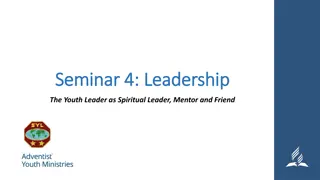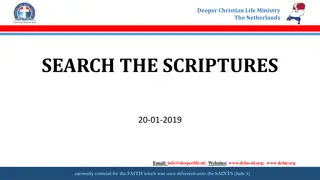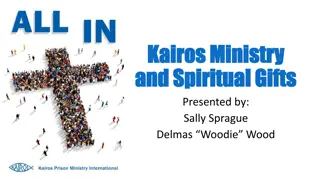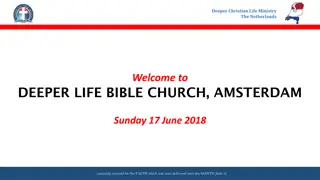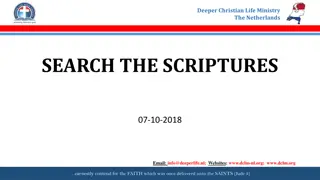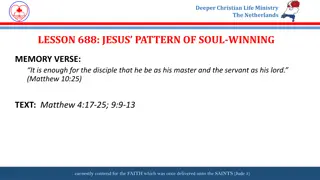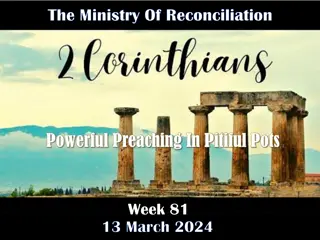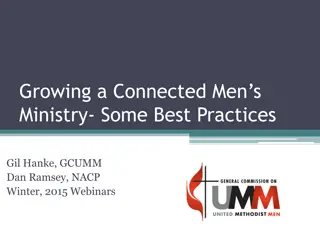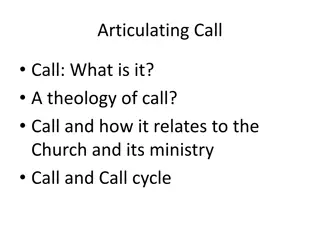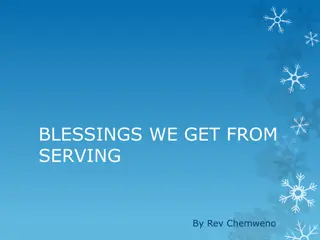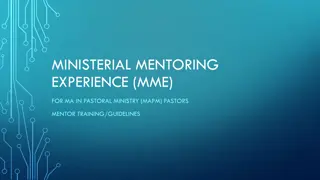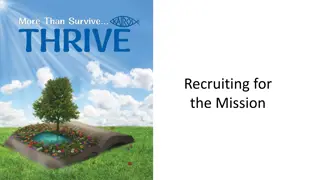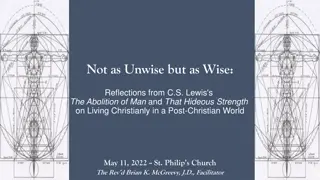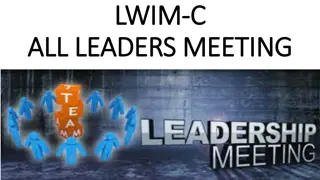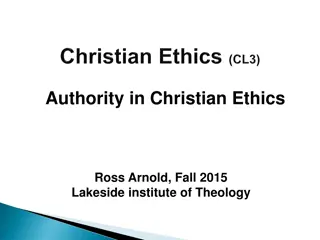Commitment to Safe Ministry Practices in a Christian Community
As a Christian community, we pledge to ensure the safety and spiritual growth of all individuals, particularly children, youth, and vulnerable adults. Our policy emphasizes the Gospel's call to ministry with proactive measures to prevent harm and address risks. Recent occurrences highlight the importance of safeguarding vulnerable members within religious organizations. These efforts align with the mission to protect against abuse and create safe environments for growth and faith development.
Download Presentation

Please find below an Image/Link to download the presentation.
The content on the website is provided AS IS for your information and personal use only. It may not be sold, licensed, or shared on other websites without obtaining consent from the author. Download presentation by click this link. If you encounter any issues during the download, it is possible that the publisher has removed the file from their server.
E N D
Presentation Transcript
Statement of Covenant As a Christian community of faith and a United Methodist congregation, we pledge to engage in the ministry of the Gospel in ways that seek to assure the safety and spiritual growth of all of our children, youth, and vulnerable adults as well as those who work with them. We seek to follow reasonable safety measures in the selection and recruitment of workers: and to implement prudent operational procedures in all ministry activities and events.
Preamble God has called us to make our ministries safe, protecting our children, youth and vulnerable adults from abuse and exploitation. God has also called us to create communities of faith where children, youth and vulnerable adults can be safe and grow strong. Jesus taught that Whoever welcomes one such child in my name welcomes me, (Mark 9:37 NRSV) and If any of you put a stumbling block before one of these little ones it would be better for you if a great millstone were fastened around your neck and you were drowned in the depth of the sea. (Matthew 18:6 NRSV).
Our Policy The Gospel calls us to be engaged in ministry with children and youth. We should not allow the risks to undermine or stop our ministry. Rather, we must: Acknowledge the risks and develop a practical plan to address these issues: Take steps to prevent harm to our children; and Continue to answer the Gospel s imperative to be in ministry with children, thus making a difference in their lives. (Safe Sanctuaries: Reducing the Risk of Abuse in the Church for Children and Youth)
CURRENT OCCURENCES MARTINSBURG, W.Va. (AP) A jury in West Virginia will hear the evidence against the Mormon Church in a lawsuit accusing local church officials of covering up allegations that the son of officials abused 12 children over more than five years. The Journal reports that the lawsuit, filed by children who were between the ages of 3 and 12 when they say they were sexually abused by Christopher Michael Jensen, will go to trial Jan. 8 in Berkeley County. Jensen was sentenced in 2013 to 35 to 75 years in prison for sexually abusing two minors. SPINDALE, North Carolina (AP) In an unprecedented move, North Carolina s state child welfare agency will participate in reviewing every new allegation of abuse and neglect involving a controversial church that has been the focus of an Associated Press investigation exposing years of physical and emotional mistreatment of congregants, including children. The state would not say what prompted the move, but it follows a series of AP stories that have cited dozens of former Word of Faith Fellowship members who say congregants are regularly beaten to purify sinners. Founded in 1979, the evangelical sect has grown to about 750 congregants in North Carolina and a total of nearly 2,000 other followers worldwide.
KNOWING THE FACTS CURRENT STATISTICS The National Center for Child Abuse and Neglect reports there are more than 3 million incidents of physical abuse and/or neglect per year in the U. S.A. That equates to more than thirty out of every one thousand children Studies have estimated that 1 out of 3 girls is sexually abused before the age of 18. Similar studies indicate 1 out of 7 boys have been sexually abused before the age of 18. Even more frightening is that these numbers may be underestimated since many children are reluctant to report abuse. The National Committee for the Prevention of Child Abuse in the U.S. reports that at least 1,490 deaths are attributed to child abuse and/or neglect occur each year.
Reasons to Implement a Child Abuse Prevention Strategy 1. Our church is a community of faith that can offer a safe haven and sanctuary where children and youth can seek advice, help, and nurture. 2. Our church is a place where more than just facts of child abuse can be taught. We can also teach and proclaim our Christian values: compassion, justice, repentance, and grace. 3. Our church is the place where children can come and learn and develop the inner strength and spiritual resources they will need to feel truly connected to God and to face suffering and evil. 4. Our church can be the place where children and adults are able to learn how to respond to painful and confusing events using the wisdom of the Scriptures.
Summarize These reports and data demonstrate that we cannot ignore the possibility that abuse could happen here. For the sake of our children and the protection of our workers against false allegations, we need to intentionally work to prevent abuse.
Abuse means harm or a threat of physical or emotional harm to another person. Abuse includes: 1. The infliction of physical or emotional injury by other than accidental means. 2. The creation of risk, or allowing the creation of risk. 3. Committing or allowing to be committed, an act of sexual abuse, sexual exploitation, or prostitution. .
Definitions Child or children or youth means any person who has no reached his/her eighteenth birthday. Exploitation means obtaining or using another person s resources, including but not limited to funds, assets or property, by deception, intimidation, or similar means, with the intent to deprive the person of those resources. Sexual abuse includes, but is not limited to, any contact or interaction in which a parent, legal guardian, or other person uses or allows, permits, or encourages the use of the child, youth, or vulnerable adult for the purposes of sexual stimulation of the perpetrator or another person. Sexual exploitation includes, but is not limited to, a situation in which a parent, legal guardian, or other person allows, permits, or encourages a child, youth, or vulnerable adult to engage in an act which constitutes prostitution under Ohio law. Sexual exploitation also includes, but is not limited to, a situation in which a parent, legal guardian, person having custodial control or supervision, or person who is responsible for the welfare of a child, youth or vulnerable adult; allows permits, or encourages the child, youth or vulnerable adult to engage in act of obscene or pornographic photographing, filming, or depicting of a child as provided under Ohio Law. Supervision means to oversee or direct a ministry or ministry activity or event. Vulnerable Adult means a person eighteen years of age or older who is unable to protect him or herself from abuse, neglect, or exploitation by others because of a physical, mental, or emotional impairment.
TYPES OF ABUSE Physical Abuse Abuse in which a person deliberately and intentionally causes bodily hard to a child. Examples may include violent battery with a weapon (knife, belt, strap, and so forth), burning, shaking, kicking, choking, fracturing bones, and any of a wide variety of non-accidental injuries to a child s body.
Emotional Abuse Abuse in which a person exposes a childe to spoke and/or unspoken violence or emotional cruelty. Emotional abuse sends a message to the child of worthlessness, badness, and being not only unloved but undeserving of love and care. Children exposed to emotional abuse may have experienced being locked in a closet, being deprived of any sign of parental affection, being constantly told they are bad or stupid, or being allowed or forced to abuse alcohol or drugs. Emotional abuse is often very difficult to prove and is devastating to the victim.
Neglect Abuse in which a person endangers a child s health, safety, or welfare through negligence. Neglect may include withholding food, clothing medical care, education, and even affection and affirmation of the child s self-worth. This is perhaps the most common form of abuse Sexual Abuse Abuse in which sexual contact between a child and an adult (or another older and more powerful youth) occurs. The child is never truly capable of consenting or resisting such contact and/or such sexual acts. Often, the child is physically and psychologically dependent upon the perpetrator of the abuse. Examples of sexual abuse may include fondling, intercourse, incest, and the exploitation of and exposure to child pornography or prostitution.
Abuse in which physical, sexual, or psychological violations of a child are inflicted regularly, intentionally, and in a stylized way by a person or persons responsible for the child s welfare. The abuser may appeal to some higher authority or power to justify the abuse. The abuse may include cruel treatment of animals or repeated threats of harm to the child, other persons, and animals. Reports of ritual abuse are often extremely horrifying and may seem to grim to be true. Children making such reports must not be ignored.
Abusers: Who Are They The abusers of our children are more often than not familiar adults trusted by the children. Abusers come from all segments of society. Abusers can be found in every racial, ethnic, economic, and social group. Some are charismatic leaders, some are very sociable, some are very sympathetic to troubled children, some are married with kids, some are young and some are old. More than 60% of child abusers who are caught abuse again. It s common for the abuser to have dozens and dozens of victims
Minor on Minor Misconduct and Abuse There are several different types of situations that can lead to abuse between minors: The first could be in which one minor is in position of power over another. For example, a case might involve a male 4th grade student who is physically almost double the weight of a female 3rd grade student and he uses his size advantage to coerce her and to injure her repeatedly over a period of weeks. She reports his behavior to her teacher and parents, but nothing is done to protect her after the first report. She continues to report the misconduct and her parents remover her from the school because they can t find no other way to assure her safety from continued assaults.
Minor Misconduct and Abuse cont... A second type of occurrence could be described as some sort of practical joke between two or more minors. This type of behavior might start out as simply one child or youth using words with sexually charged connotations to embarrass or humiliate another. In today s world when, when such a thing is broadcast over the internet through emails, blogs, websites, and text messages, the painful effect is exponentially magnified for the victims. Finally, we know that sexual activity between minors is commonplace. However, the frequency with which it occurs does not make this behavior always consensual or acceptable. All fifty states have statues defining the terms in which sexual contact between persons is criminal. Most states find sexual contact with a minor who is more than 4 years younger than the adult to be criminal behavior. Similarly, sexual contact between minors who are more than 4 years apart in age is defined as criminal conduct.
Within the Church Within our churches, who are the abusers? They may be Sunday School teachers, nursery workers, preschool teachers, children s choir helpers, vacation Bible school leaders, camp counselors, youth group counselors, clergy persons, or anyone else.
How Does Abuse Happen? Child sexual abuse happens when a person exerts his or her power over a child in ways that harm and/or exploit the child. In other words, the abuser is powerful; the child is vulnerable. There may be several sources from which the abuser gains power over the child: size, position, knowledge, money, just to name a few. All these things work to make the abuser believe that he or she is able to behave inappropriately toward a child and that the child will be unable to stop the abusive behavior. The child is vulnerable to an abuser as a result of having fewer resources available to him or her. The child is physically smaller and weaker, intellectually less mature, and economically dependent upon the abuser or some other adult.
Wesley United Methodist Safe Sanctuary Policy Screening 1. All staff an volunteers who may have regular or direct contact with children, youth or vulnerable adults undergo a background screening including: Standard contact information Experience/qualifications for the position Voluntary disclosure of past criminal history, including criminal charges Authorization allowing the church to secure any background screening to be conducted and/or to contact references. Listing of 2 non-relative references. This list should have complete contact information for all references.
Safe Sanctuary Policy continued. 2. 3. Criminal records check. Each conviction should be evaluated in view of all the facts, including the date of the conviction, the nature of the offense, the position sought, applicable law, and obligations imposed by Amended Senate Bill 187. Criminal background checks with be repeated every 3-5 years for ALL staff, including clergy, and volunteers. Persons who have a break in volunteer or paid service of one or more years may be required to undergo a new background screening. Volunteers will demonstrate an active relationship with the church for at least 6 months before being allowed to be in a supervisory role in activities for children, youth or vulnerable adults. With new staff hires, references deemed adequate by the hiring supervisor may replace the 6 month waiting period. 4. 5.
Safe Sanctuary Policy continued. Supervision 1. Staff and volunteers that are working with children, youth and vulnerable adults will be trained over Safe Sanctuaries Policy via PowerPoint and/or in the classroom. 2. Minimum supervisory standards should include the two-adult rule or the rule of three . 1. The two-adult rule requires that, regardless the size of the group, there will ALWAYS be 2 unrelated adults present. This may include the presence of an assigned adult roamer who moves in and out of rooms and places where ministry activities and events occur. 2. When transporting children, youth or vulnerable adults for a church ministry event or activity, an additional adult should accompany the driver of the vehicle 3. Unrelated adults is defined as 2 people who do not live in the same household. 4. The rule of three can be followed for ministries with youth, age 12 and older. The rule of three states: there will always be a minimum of 3 unrelated people together for ministry events, this can be two youth and one adult, or one youth and two adults.
Safe Sanctuary Policy continued Supervision 3. Children, youth, and vulnerable adults are to be supervised while attending a ministry event or activity. 4. ALL ministry activities and events should occur in open view. Each room or space should be open to public view. Doors have a viewing window or an open door. 5. Before the start of every activity or event, appropriate contact information should be collected. 6. Activities involving transportation require written and signed permission from parents or legal guardians. 7. For overnight situations, a ministry plan including travel plans and sleeping arrangements should be made available in writing to and should be signed by parents or legal guardian prior to the event. 8. No person shall supervise an age group unless they are at least 18 years of age and at least 3 years older than the children/youth being supervised.
Safe Sanctuary Policy continued Reporting Safe Sanctuaries reporting is required by an staff or volunteer who personally witnesses an incident of abuse or exploitation or when an allegation of such an incident is made by child, youth, or vulnerable adult. IT IS CRUCIAL THAT REPORTING BE IMMEDIATE AND THE ALLEGATIONS DEALT WITH AS SOON AS POSSIBLE TO THE INCIDENT OR DISCLOSURE. 1. If the victim is in immediate need of medical attention, the appropriate medical assistance will be obtained. If the alleged perpetrator is onsite and danger is perceived, local police will be called.
Safe Sanctuary Policy continued 2. Upon securing medical assistance for the victim and ensuring the safety of the environment, the staff person or volunteer must report the incident immediately to the person in charge of the ministry or activity using the Report of Suspected Incident of Child Abuse with his/her age, reason for suspected abuse and any other helpful information to help the investigation. The senior pastor (or church council leader) will ensure contact is made with Child Protective Services for Ohio Health and Family Services. However, if the volunteer also happens to be a mandatory reporter, the volunteer should, at a minimum co-report with the senior pastor. When making a report by telephone, it is advisable that it be conducted in the presence of an objective witness. The witness can verify the report has been made and who made the report. All reports will be documented and securely filed. 3. Notify the parents or legal guardians of the victim. Take whatever steps are necessary to ensure the safety and well-being of the victim until the parent/legal guardians arrive. However, if one or both of the parents/legal guardians is the alleged perpetrator, follow the advice of the authorities concerning notification.
Safe Sanctuaries Policy continued 4. The senior pastor (or church council leader) shall immediately call the superintendent of the district in which the church resides and report the allegations. The District Superintendent will immediately report the situation to the Assistant to the Bishop and Communications Director at the West Ohio Conference office, as set forth in the Crisis Communications Guidelines for the West Ohio Conference. Further communication or steps taken with the staff, congregation, community, or media shall only be taken after the consultation with the District Superintendent and the Conference office. The person in charge of the ministry activity or event MUST keep a written report of the steps taken by the church in response to the reported abuse. The report should be brief and contain only factual information relevant to the situation. It should be written in ink or typed to prevent it from being changed and kept in a secure location. 5. 6. 7.
Safe Sanctuaries Policy continued Response Plan A quick, compassionate, and unified response to a reported incident of abuse is expected. All allegations will be taken seriously. In cases reported or observed abuse there shall be cooperation with all official investigating agencies. 1. All media requests for statements should be directed to a designated church spokesperson who will work in conjunction with the District Superintendent and the Conference Crisis Communication Team. 2. Immediately, yet with dignity and respect for the sacred worth of the accused, remove the accused from further involvement with children, youth, or vulnerable adults and the accused will be advised that there has been an allegation of abuse. Details will not be discussed at the time of removal and things will be handled in a discreet manner, recognizing that there will be an investigation by either state or church authorities or both.
Safe Sanctuaries Policy continued 3. When it has been alleged that a staff member or volunteer, has committed an act of abuse or exploitation, the staff member or volunteer shall be required to refrain from all ministry activities and events with children, youth, and vulnerable adults until the incident has been fully resolved by the appropriate civil authorities and in accordance with The Book of Discipline. All allegations will be taken seriously. Wesley will reach out and respond in a positive and supportive manner to the victim and the victim s family. We will show care and support to help prevent further hurt. Pastoral resources will be extended if needed. The care and safety of the victim is the first priority. Wesley will provide a supportive atmosphere to all those who are affected, offering both objectivity and empathy as it seeks to create a climate in which healing can take place. 4.
In Closing You must complete the test over this PowerPoint and turn it in to the office. We will be in touch with you to fill out Covenant Forms and to have you update your contact information and references.





